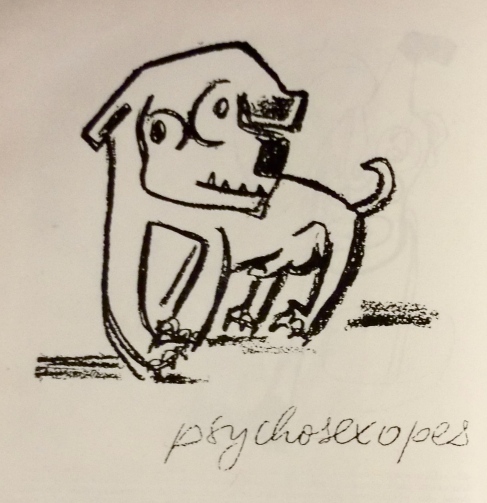These images were produced by experimental subjects taking part in the ‘Experimental Psychosis’ project at the Prague Psychiatric Research Institute in the late 1950s and 1960s. The research programme, headed by psychiatrist Miloš Vojtěchovský, involved EEG monitoring and the analysis of creative graphic output (paintings, charcoal and ink drawings, among others) of healthy individuals under the influence of a variety of psychotropic drugs (including psilocybin, mescaline, adrenaline derivatives, dimethyl- and diethyltryptamine, and perhaps most significantly, LSD). These were then compared to the results of the same tests for experimental subjects with a diagnosis of schizophrenia during psychotic episodes, as a means to examine whether hallucinogens induced a form of ‘model psychosis’.
The subject who painted the faces above reported being unable to record the constantly changing colours quickly enough as the hallucination was happening, and so the resulting black and red images do not capture the full range detail of the images experienced.[i] The gradual distortion of the facial features is reminiscent of the progressive deterioration of Louis Wain’s ‘Kaleidescope Cats’, thought to be a result of his worsening mental illness.
Whilst ultimately the experimenters were doubtful as to whether the parallels between psychosis and drug-induced hallucinations went beyond mere analogy, they argued that inducing ‘model psychosis’ had a very important didactic function for mental health professionals, as it provided a new way for staff to directly experience symptoms of mental illness that they had hitherto only been able to observe in their patients. They hoped that such phenomenological experiences could be integrated into the training of psychiatrists and psychiatric nurses, to enable a more humane therapeutic relationship.[ii]
This illustration is accompanied by an explanatory note exploring the word-game that the experimental subject was engaging in during their LSD-induced experience. The comical canine cariacature with its exaggerated genitals is ‘Psychosexopes’, which can be roughly translated into English as ‘Psychosexdog’ It is a visual representation of the experimental subject’s chain of thoughts, which pun on the fact that the plural of the Czech word for pes, meaning dog, is psy. An annotation beneath the image reads, ‘psyche – higher nervous activity – experiments with dogs, sexuality – psychoanalysis’.[iii]
According to officially endorsed ideology under Communism, psychic phenomena were reducible to the products of ‘higher nervous activity’ in the Pavlovian sense. Experimental work in the Pavlovian tradition often made use of experiments with dogs (psy). The term ‘psy, in tandem with this particular dog’s obvious sexuality, in turn brings the subject’s thoughts back to psychoanalysis. Given that psychoanalysis was technically regarded as a pseudoscience by the regime – with scientists having to have special permission to access the works of Freud which were kept in separate rooms in state libraries – the amalgamation of Pavlov with Freud in this wordplay signifies the bringing together of two ideological opposites, and has a subversive element.
Although the identity of the experimental subject remains undisclosed by the authors of the book, it is perhaps worth noting that at least one of the project’s collaborators, Stanislav Grof, was a trained psychoanalyst, and went on to use LSD to support therapeutic sessions which did draw explicitly from psychoanalytic models. The fact that such work was being carried out during the 1960s in Czechoslovakia is testament to the possibilities for theoretical autonomy in medical research at the time. In spite of the Party’s disapproval of psychoanalysis, the experimental psychosis researchers were, in practice, able to continue to pursue their own interpretations within experimental contexts without much direct state regulation, even before the Prague Spring Reforms of 1968.

